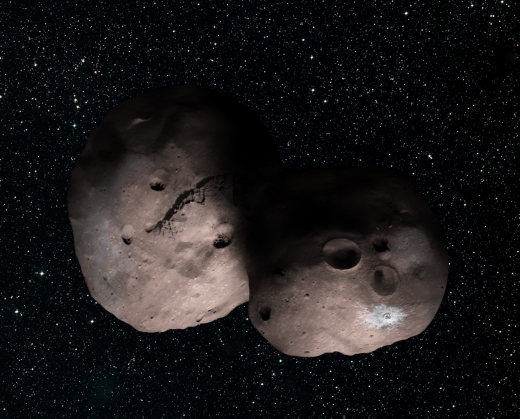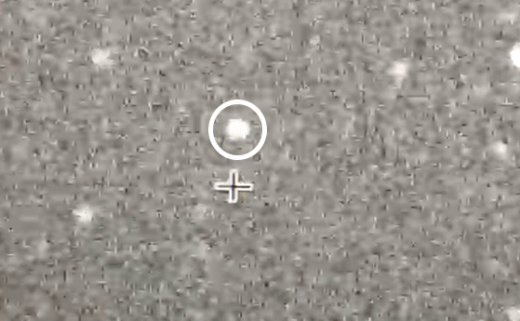Back in June we tracked what the New Horizons team was doing to refine our knowledge of 2014 MU69, the Kuiper Belt Object toward which New Horizons is now moving (see New Horizons: Occultations in Preparation for MU69). There were actually three of these events, on June 3, July 10 and July 17 of this year, studied not only by team members on the ground in Argentina and South Africa but by observatories like SOFIA (the airborne Stratospheric Observatory for Infrared Astronomy) and the Hubble Space Telescope. Hubble and the European Space Agency’s Gaia satellite were critical in calculating where the shadow of MU69 would fall.
Learning more about the distant KBO is a key part of the encounter, given the possibilities of debris around MU69 in the upcoming flyby. You’ll recall that the Pluto/Charon system was analyzed painstakingly in advance of the New Horizons flyby for the same reason. The occultations, in which the object passes in front of a distant star, allowed the team to take new readings on MU69, revealing that the KBO is no more than 30 kilometers long.
If, indeed, it is a single object. We may be dealing with what scientists involved with the project are calling an ‘extreme prolate spheroid’ (with an elongated, football-like shape (think American football as opposed to international). For that matter, we can’t rule out a binary, with two objects in close proximity or perhaps even touching (this is known as a contact binary).
“This new finding is simply spectacular. The shape of MU69 is truly provocative, and could mean another first for New Horizons going to a binary object in the Kuiper Belt,” said Alan Stern, mission principal investigator from the Southwest Research Institute (SwRI) in Boulder, Colorado. “I could not be happier with the occultation results, which promise a scientific bonanza for the flyby.”

Image: One artist’s concept of Kuiper Belt object 2014 MU69, the next flyby target for NASA’s New Horizons mission. This binary concept is based on telescope observations made at Patagonia, Argentina on July 17, 2017 when MU69 passed in front of a star. New Horizons scientists theorize that it could be a single body with a large chunk taken out of it, or two bodies that are close together or even touching. Credit: NASA/Johns Hopkins University Applied Physics Laboratory/Southwest Research Institute/Alex Parker.
But as we ponder the results from the occultations, consider just how successful the effort has been. We’re tracking the shadow of an object as it passes in front of a star, the object being 6.5 billion kilometers from the Earth. More than sixty observers dealt with high winds and cold to set up 24 mobile telescopes in the area of Chubut and Santa Cruz, Argentina on July 17. Amanda Zangari (SwRI), a New Horizons co-investigator and the first to see the signature of MU69 in the occultation data, exulted over the team’s success: “We nailed it spectacularly.”
It’s also heartening to see the level of public support for this work in the Argentine community of Comodoro Rivadavia. Local authorities closed a national highway for two hours to prevent car headlights from interfering with the observations, and nearby street lights were turned off to ensure darkness. Local residents parked trucks to serve as windbreaks.

Image: NASA’s New Horizons team trained mobile telescopes on an unnamed star (circled) from a remote area of Argentina on July 17, 2017. A Kuiper Belt object 4.1 billion miles from Earth – known as 2014 MU69 – briefly blocked the light from the background star, in what’s known as an occultation. The time difference between frames is 200 milliseconds, or 0.2 seconds. This data will help scientists better measure the shape, size and environment around the object. The New Horizons spacecraft will fly by this ancient relic of solar system formation on Jan. 1, 2019. It will be the most distant object ever explored by a spacecraft. Click here to see a longer version of the occultation. Credit: NASA/Johns Hopkins University Applied Physics Laboratory/Southwest Research Institute/ Adriana Ocampo.
“This effort, spanning six months, three spacecraft, 24 portable ground-based telescopes, and NASA’s SOFIA airborne observatory was the most challenging stellar occultation in the history of astronomy, but we did it!” adds Alan Stern. “We spied the shape and size of 2014 MU69 for the first time, a Kuiper Belt scientific treasure we will explore just over 17 months from now. Thanks to this success we can now plan the upcoming flyby with much more confidence.”
So we proceed toward the most distant flyby in the history of space exploration, scheduled for January 1, 2019. A good deal of data analysis lies ahead for those studying the occultation results, but this most challenging ground occultation observation campaign in history has given us what we need. Be aware of the mission’s KBO Chasers page (and the hashtag #mu69occ) as you follow New Horizons’ next encounter online.



Do we have spectral data of the ocultation?
Unless it has a thin atmosphere there will be none, I think it is to cold and not massive enough to have one.
Since there is a possibility that it’s a contact binary or similar, maybe there is some outgassing. Or maybe there is outgassing from previous impacts. So it would be interesting to know the spectral data.
Reflection spectra of asteroids’ materials are taken (and photometric color measurements also give clues to their compositions), but:
I don’t know if either of those techniques are effective with such distant, extremely dim objects way out there (they might be if the instruments are aboard satellites). Such space-based (or even ground-based) instruments might also be able to compensate for the dim light by taking longer exposures (film spectrograms can do this, and electronic CCD imager technology may be able to do it for taking spectra and/or for making photometric color measurements).